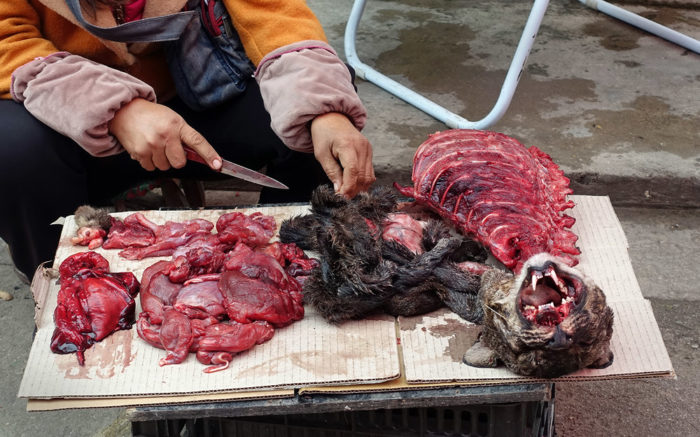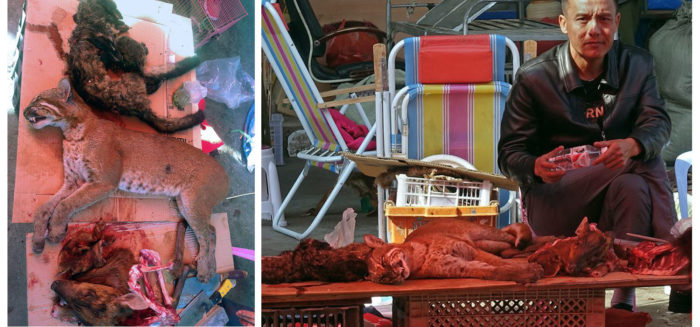Mongla lies on the border of the Xishuangbanna Dai Autonomous Prefecture in southwestern China and Shan State in northeastern Burma. Situated in the heart of the Golden Triangle, the city is known among other sad epithets as the wildlife trafficking capital of the world and for drugs, gambling, and prostitution.
Despite officially belonging to Burma, the area operates as a special armed region, making it both difficult and expensive (if not off limits) for most Burmese and non-Chinese nationals to visit. Furthermore, its overwhelming influence from China—ranging from its currency, technology, and infrastructure to the language, entertainment, and food—also deters Burmese and foreign tourists in Burma from visiting Mongla. Instead, it is frequented annually by hundreds of thousands of visitors from mainland China, who drive across the border “illegally” from Daluo without a visa or border pass.
Despite their unauthorized status, there is little that is either secret or mysterious about their travel and whereabouts. Mainland Chinese enter Burma on roads that circumvent the official port of entry, but are still monitored by local government officials, who jot down names and receive 53 CNY (US$8) in cash per visitor. Upon their return, they are subject to stringent checks by Chinese customs agents, who will thoroughly search their car and belongings for illegal contraband. Illicit goods, including drugs, wild animals, and weapons, are both less regulated and more readily accessible in Burma than in China. If smugglers are caught, they face stiff fines and years in jail.

Mongla’s large outdoor market in the city center is about the size of a soccer field, and is open daily. Despite offering few visual attractions, the market features a vast selection of produce and household goods (about 90 percent of which have been imported from China) as well as a smaller variety of fresh vegetables and fruits that have been grown locally. Vendors are typically unemployed Han from mainland China, but also comprise a number of Shan (known as Dai in China), Akha, and other ethnic minority groups from Mongla’s surrounding countryside. Between rows of fresh fish, vegetables, and flowers, the market includes a section for wildlife with perhaps 15 to 20 traffickers of increasingly threatened animals, including rare and endangered species.

It is a heart-rending scene I returned to repeatedly over the course of my brief stay in the city, and is among the saddest sites I have seen.
Small monkeys; birds of prey with thick, dark plumage and piercing, orange eyes; green pigeons; hairless moles; slow loris; and other fur-covered animals—all alive—crouch listlessly or flap in fear in cramped metal wire cages. Some are curled into tight balls with their heads tucked away or keep their eyes semi-closed to the bright daylight. Their suffering is compounded by an array of fresh meat spread atop flattened cardboard boxes that are laid out on the ground or sit on top of black plastic crates.

The day’s catch includes an assortment of barking deer, or muntjac, northern serow, civets, pheasants, clouded leopard, large soft-shelled turtles, and other indigenous species from the mountains—the few remaining spots of wilderness around Burma and Southeast Asia I imagine not yet desecrated by mining, logging, and other human activity.
In addition to live animals and fresh meat, there are countless dried animal parts strewn across the ground or separated into neatly arranged piles. I am struck by the sheer magnitude of pieces, which include coiled snake skins, quills, skulls, carcasses, bones, paws, cloven hoofs, fur pelts, tusks, horn, antlers, and genitalia. As I venture to ask vendors and their customers questions, my horror and disbelief turn to despair and condemnation.

The animals are primarily used to steep in liquor as a tonic or elixir and for medicinal purposes. Like vitamins, each seems to serve a specific purpose. Small live owls cost 70 CNY (US$11) each and are said to cure headaches and other head ailments. Pangolin skins, a fully protected animal under both Chinese and Burmese domestic law and the multiparty Convention on International Trade in Endangered Species of Wild Fauna and Flora (CITES), sell for 1,600 CNY (US$245) per pound and are supposedly good for the vertebra and spine. Dried chunks of elephant skin cut into crude rectangles resemble discarded scraps of fabric. They are said to cure stomach illnesses, and cost 200 CNY to 250 CNY (US$30 to $38) per pound. The thicker skin is more expensive. Other animal parts help revitalize kidney or liver function while tiger penises, of which there are a seemingly endless number, boost male virility.
Like dried meat, fresh meat is also steeped in alcohol or eaten with the belief that it will strengthen the body’s immune system. Prices range from 45 CNY (US$7) for a pound of barking deer to 8,000 CNY (US$1,227) for a whole Asiatic golden cat that appears to have been recently killed by a single bullet to the belly. Blood from the wound still looks fresh. In addition, fresh northern serow meat sells for 80 CNY (US$12) per pound while the head by itself costs 150 CNY (US$23). Other wildlife parts are sold as trophy pieces, for decoration, or as amulets and lucky keychains, including severed monkey hands with paw pads that are still soft.
Unacquainted with the wildlife market, but accustomed to similar or higher prices for ordinary material goods, I am taken aback by the relatively low cost of increasingly finite resources with immeasurable value to the natural ecosystem and humankind.

Business peaks in winter during the week-long Chinese Spring Festival, or Lunar New Year, when the number of wealthy compatriots arriving from mainland China rises. They sport high-end smartphones, diamond-encrusted watches, and other expensive accessories and hail from cities as distant as Harbin in northeast China, near the Russian border, and closer metropolises like Kunming. They buy mostly for personal consumption or as gifts for friends and relatives.
A tiger’s leg, which is prized as a particularly effective restorative, fetches a premium at 3,000 CNY (US$460). The limb is severed from the lower shin and comes replete with an exposed bone, dried marrow, sinewy strands of tendon, four massive claws, and a trimming of fur at its base. I ask a potential customer whether it might be fake. I hope it is. He acknowledges that while imitations exist, most products here are, in fact, genuine and too difficult to fabricate well enough to make counterfeiting a worthwhile pursuit. Because the client’s main concern is evading China’s border control agents, the vendor readily agrees to mail him his purchase immediately upon payment. It turns out shipping wildlife from Mongla to China is no problem. One tiger leg takes five to six days.

Wildlife trafficking and associated environmental crime is a lucrative industry, with an estimated value of $8 to $10 billion annually in Southeast Asia alone, according to the US Trade Representative, a federal agency that develops and coordinates US international trade, commodity, and direct investment policy, as well as oversees negotiations with other countries. While often portrayed as a dangerous activity involving organized crime syndicates, a 2009 Smithsonian article by Charles Bergman on the illicit wildlife economy in Ecuador offers a different perspective: “It’s not the shadowy activity people might think; it’s more like an open secret,” he writes.
Despite its visibility, wildlife crime persists unchecked in Southeast Asia, as in Latin America, for myriad reasons, including the limited capacity of officials to conduct regular inspections, weak or inadequate regulations and law enforcement, and a lack of resources or resolve at the local level. This has evoked new responses from the global community to raise public awareness and encourage locals and tourists alike to play a more pivotal role in enforcing control, with “wildlife trade hotspots” like Mongla now marked by the World Wildlife Fund as both “trouble areas” and “opportunities for great conservation success.”

So what can be done to stem the illegal wildlife trade?
To start, the following measures can help market-goers and other travelers become more familiar with and better assess the trade in wildlife. These approaches can also provide conservationists with empirical evidence of the illegal trade, help them to identify trends and understand the changing conditions at the market, and enable them to ascertain the impact of their work and influence wildlife trafficking enforcement policies.
Take pictures: Visual documentation serves as important evidence of wildlife trafficking and can help with the correct identification of animal species. While large cameras typically attract attention, it is common for market-goers to take photos and video of the wildlife being sold with their smartphones or other inconspicuous devices.
Watch and observe: Take a rough count of the number of vendors and customers at the market, the frequency and pattern of sales, the volume of live and dead wild animals and wildlife parts, the availability of water and prevalence of hand and utensil washing to help prevent the spread of zoonotic diseases, and other trends and public behaviors.

Talk and listen: Ask vendors and customers questions about the price of wildlife, the types of species for sale, the number of buyers and their consumption habits, the purpose of sales, the intended destination and means of transport, hygienic conditions at the market, and other aspects of the trade chain. Questions directed to traders about the source location of wildlife, poachers and hunters, and the sellers themselves are less likely to elicit a forthcoming response. Mandarin Chinese is often the standard language of communication given that demand is driven by mainland Chinese consumers.
Share information: In recent years, effective new analytical tools and technologies have become available to the public to help combat wildlife trafficking and improve government, foundation, international agency, and NGO-led environmental conservation efforts. In Southeast Asia, these include:
- Wildlife Witness, an easy-to-use app that encourages users to safely photograph the wildlife, record the exact location, and report the activity to TRAFFIC, the wildlife trade monitoring network.
- Wildscan, a Vietnam-based app that offers a similar endangered species identification and response option.
In addition, the Oxford Wildlife Trade Research Group at Oxford Brookes University maintains a database that tracks the illegal trade in Mongla and is sourced in part with data contributed voluntarily by travelers.

Further responses to combat the illegal wildlife trade are widespread and multifarious. For non-travelers and people committed to improving animal welfare from home, help can be provided by allocating resources to fund the enforcement of CITES provisions and maintenance of nature reserves. In Asia, there are many national and international NGOs, including the World Wildlife Fund, TRAFFIC, Fund for Animals, China Exploration & Research Society, Wildlife Conservation Society, Nature Conservancy, Wild Aid, and International Fund for Animal Welfare. These organizations are dedicated to monitoring illicit markets, reducing consumer demand, and protecting threatened species.
The global community can also assist with public education and awareness by sharing information online. At the same time, people who buy animals and wildlife products should make use of cultivated alternatives over wild stocks to stop the illegal trade. Finally, products including food, medicine, supplements, cosmetics, jewelry, clothing, décor, and furniture made from wild-sourced imports should only be purchased from licensed sources with genuine CITES certificates of species and origin.
Republished with the kind permission of Terrain.org: A Journal of the Built + Natural Environments.

















